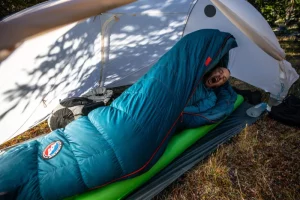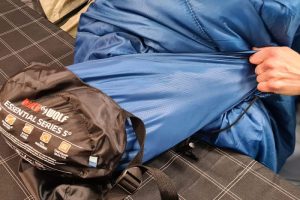Have you ever wondered how to efficiently carry your sleeping bag during a hiking or backpacking trip? Properly attaching your sleeping bag to your backpack is essential for ensuring convenience, weight distribution, and easy access. In this article, we will guide you through How to attach sleeping bag to backpack, step by step. Whether you’re a seasoned hiker or a novice adventurer, these tips will help you make the most out of your outdoor experiences.
Introduction
When embarking on a hiking or backpacking adventure, having a reliable and comfortable backpack is crucial. However, managing the additional bulk of a sleeping bag can be challenging without proper attachment methods. By securely fastening your sleeping bag to your backpack, you can optimize your packing space, maintain a balanced load, and keep your sleeping bag easily accessible whenever needed.
Why Attach a Sleeping Bag to a Backpack?

Attaching a sleeping bag to your backpack offers several advantages. First and foremost, it frees up valuable internal space within your backpack, allowing you to pack other essential items more efficiently.
Additionally, attaching your sleeping bag externally can distribute weight evenly across your back, promoting better posture and reducing strain on your shoulders and hips.
Choosing the Right Backpack
Before you can attach a sleeping bag to your backpack, it’s crucial to select a backpack suitable for your needs. Consider factors such as capacity, weight distribution, comfort, and durability. Opt for a backpack with external attachment points, compression straps, and compartments specifically designed for securing gear like a sleeping bag.
Selecting a Sleeping Bag
Choosing the right sleeping bag is equally important. Select a sleeping bag that suits the weather conditions and temperature ranges you anticipate encountering on your journey. Ensure that the sleeping bag is lightweight, compactable, and equipped with compression straps or a stuff sack for easier attachment and storage.
Preparing the Sleeping Bag
Before attaching your sleeping bag to the backpack, it’s essential to prepare it properly. Start by rolling or folding the sleeping bag tightly to reduce its overall size. Ensure that any loose straps or cords are secured and that the bag is clean and dry to prevent any moisture-related issues during your trip.
Roll or Fold: Start by rolling or folding your sleeping bag tightly to reduce its overall size. This will make it easier to pack and attach to your backpack. Ensure that the sleeping bag is folded or rolled in a way that best suits its specific design and shape.
Clean and Dry: It’s important to ensure that your sleeping bag is clean and dry before packing it. If your sleeping bag is dirty, follow the manufacturer’s instructions for cleaning. Let it air dry thoroughly before rolling or folding it for packing. This will help prevent any unpleasant odors or mold growth.
Consider a Stuff Sack or Compression Sack: Using a stuff sack or compression sack can further assist in preparing your sleeping bag. These sacks are designed to compress the sleeping bag to a smaller size, making it easier to pack and attach to your backpack. Place your rolled or folded sleeping bag inside the sack and tighten the straps or compression system to reduce its size.
Compression Sacks and Stuff Sacks

Compression sacks and stuff sacks are invaluable tools for compacting and organizing your sleeping bag. These sacks not only reduce the overall size of the sleeping bag but also protect it from moisture and potential damage. Place your sleeping bag inside the sack, tighten the straps or compression system, and make sure it’s secure before attaching it to your backpack.
External Attachment Methods
Straps and Compression Systems
One common method of attaching a sleeping bag externally is by using straps or compression systems. Many backpacks feature adjustable straps that can be fastened around the sleeping bag, holding it securely in place. Compression systems, often found on the sides of backpacks, allow you to compress the sleeping bag further, reducing its size and minimizing bulk.
Lashing and Bungee Cords
Lashing your sleeping bag to the exterior of your backpack using bungee cords or additional straps is another effective attachment method. Secure the sleeping bag to the backpack’s external attachment points or use lashing techniques to fasten it securely. Be sure to evenly distribute the weight to maintain balance.
Molle Webbing System
For backpacks equipped with a Molle (Modular Lightweight Load-carrying Equipment) webbing system, attaching a sleeping bag becomes even more convenient.
The Molle system consists of rows of durable nylon webbing that allow for the attachment of various gear and accessories. Utilize carabiners, webbing straps, or additional Molle-compatible pouches to secure your sleeping bag.
Internal Attachment Methods
Sleeping Bag Compartment
If your backpack has a dedicated sleeping bag compartment, make use of it. These compartments are designed to accommodate sleeping bags, and they usually have separate access points, allowing you to retrieve your sleeping bag without disturbing other items in your backpack.
Insert your rolled or folded sleeping bag into the designated compartment and secure it with any provided straps or fasteners.
Pack Liner
Another internal attachment method involves using a pack liner or a waterproof bag to enclose your sleeping bag within the backpack.
This method ensures that your sleeping bag remains protected from moisture and keeps the rest of your gear dry. Place your sleeping bag inside the liner or waterproof bag and position it at the bottom of your backpack.
Compression Straps
Some backpacks come equipped with compression straps on the inside, which can be used to secure your sleeping bag. Insert your sleeping bag into the main compartment of your backpack and tighten the compression straps, ensuring a snug fit.
This method not only keeps your sleeping bag secure but also helps compress your gear for improved weight distribution.
Properly Packing the Sleeping Bag

When attaching your sleeping bag, it’s crucial to pack it correctly to avoid discomfort and ensure easy access. Place your sleeping bag in a position that allows for even weight distribution, preferably centered and close to your back. Avoid positioning it too high or too low, as it can affect your balance and hinder your movement.
Balancing the Weight Distribution
Maintaining proper weight distribution is key to a comfortable and enjoyable hiking experience. Ensure that the weight of your backpack is evenly distributed between the sleeping bag compartment and other compartments or sections. Adjust the straps and compression systems as necessary to achieve balance and stability.
Tips for Hiking with an Attached Sleeping Bag
To enhance your hiking experience while carrying an attached sleeping bag, consider the following tips:
- Adjust the straps and compression systems periodically to maintain a secure and balanced load.
- Take frequent breaks to rest and readjust your backpack, ensuring maximum comfort throughout your journey.
- Familiarize yourself with the attachment methods before your trip to save time and minimize frustration on the trail.
- Secure any loose straps or cords to prevent them from getting entangled or caught on branches or other obstacles.
- Test the weight distribution and balance of your backpack before embarking on longer hikes to avoid discomfort or potential injuries.
FAQs
Can I attach any type of sleeping bag to a backpack?
Yes, you can attach various types of sleeping bags to backpacks, including mummy bags, rectangular bags, and ultralight bags. Ensure that your sleeping bag is compactable, lightweight, and compatible with your chosen attachment method.
How do I prevent my sleeping bag from getting wet while attached?
To protect your sleeping bag from moisture, consider using a waterproof stuff sack or pack liner. Additionally, choose a backpack with a durable and water-resistant exterior. Avoid attaching the sleeping bag to the outside of the backpack during heavy rain or wet conditions.
Can I attach my sleeping bag to the top or bottom of the backpack?
While the most common attachment points are the sides of the backpack, some backpacks allow for top or bottom attachments. Follow the manufacturer’s instructions and ensure that the attachment method you choose maintains a balanced load and doesn’t interfere with your comfort or mobility.
Are there any risks of attaching a sleeping bag externally?
Attaching a sleeping bag externally may expose it to external elements such as rain, snow, or branches. It’s important to choose a durable and weather-resistant sleeping bag and take precautions to protect it from potential damage. Additionally, ensure that the attachment method is secure to prevent the sleeping bag from coming loose during your hike.
Can I attach a sleeping bag to a daypack?
Yes, you can attach a sleeping bag to a daypack using similar attachment methods. However, consider the size and capacity of your daypack and ensure that the attachment doesn’t compromise your comfort or the backpack’s weight distribution.
Conclusion
Attaching a sleeping bag to your backpack is an essential skill for outdoor enthusiasts. By following the methods and tips outlined in this article, you can ensure that your sleeping bag is properly secured, conveniently accessible, and well-protected during your hiking or backpacking adventures. Remember to choose a suitable backpack, prepare your sleeping bag correctly, and utilize the various attachment methods available. With a well-attached sleeping bag, you can enjoy a comfortable night’s sleep under the stars.

